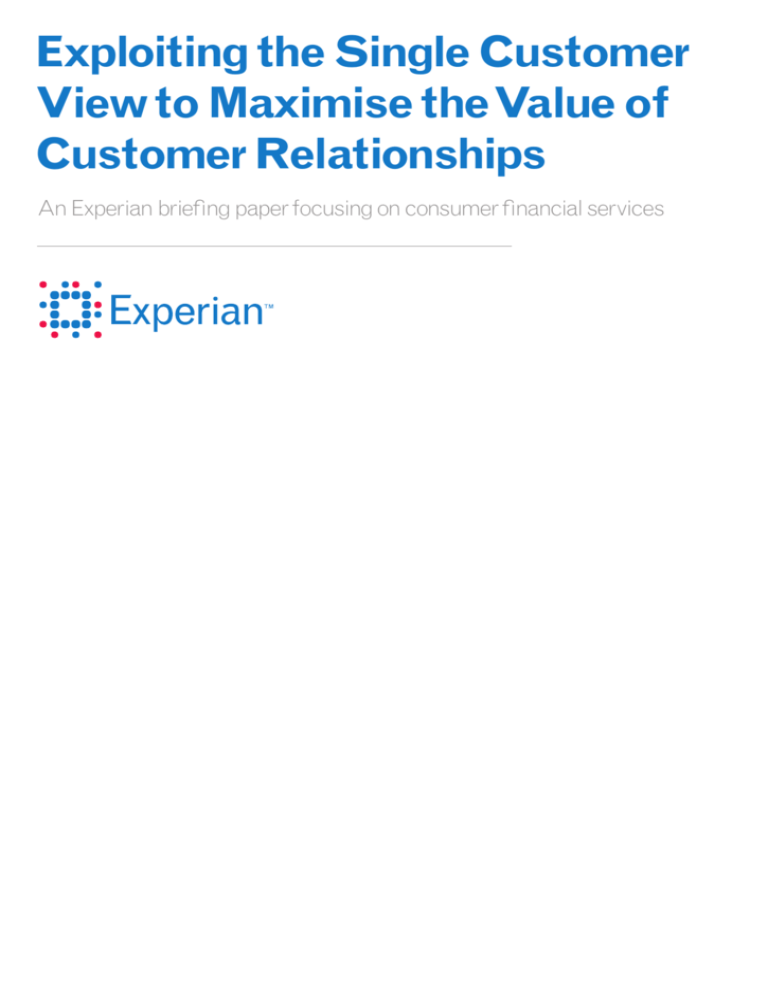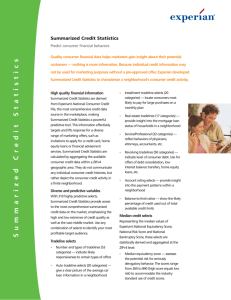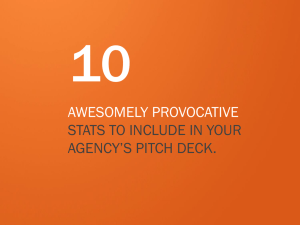
Exploiting the Single Customer
View to Maximise the Value of
Customer Relationships
An Experian briefing paper focusing on consumer financial services
Contents
Executive summary ................................................................................... pg 2
Introduction ............................................................................................... pg 3
What is a single customer view? ............................................................. pg 5
Obstacles to achieving a single customer view ...................................... pg 6
Single customer view in retail banking .................................................... pg 8
Benefits of a single customer view ........................................................... pg 10
Single customer view in practice .............................................................. pg 11
Exploiting the single customer view ........................................................ pg 12
Conclusion ................................................................................................. pg 13
Why choose Experian to supply your single customer view..................... pg 14
“Financial services and building societies
have more than 20% of their customers with
more than one account.” Pg. 4
“By achieving this single view, an
organisation is able to understand a
customer’s history, their lifetime value,
risk, potential exposure to debt, how
many products they hold, and even their
propensity to buy new goods and services.”
Pg. 5
1
www.experian.co.uk
Executive summary
This briefing paper examines the key issues, drivers and challenges that
businesses face in achieving and exploiting a single view of their customers.
The cornerstone of a single customer view is the ability to identify all the
accounts and products held by a customer. Every customer wants to be treated
as an individual and not as series of disconnected accounts. For organisations
within financial services, telecommunications, retail, utilities and retail banking
this single customer view approach will bring significant benefits.
It helps organisations to better understand their customer relationships
and improve customer retention, which is imperative in the current financial
climate. A single customer view also allows for better targeted cross-selling
and up-selling for more profitable business, whilst at the same time supporting
responsible lending, and ensuring that customers are managed in a fair and
compliant way.
Within consumer financial services, the highest investment returns occur when
customer centricity extends to risk management and offers the added bonus of
offering the prospect of decreased capital needs.
This briefing paper explains the meaning and implications of a single
customer view, how it can be achieved and the many benefits it can bring to an
organisation, from simple regulatory compliance through to enhanced customer
service and greater profitability.
2
www.experian.co.uk
Introduction
The impact of the collapse of Northern Rock and the ensuing financial crisis
has been far reaching –making it by far the biggest driver behind the push for
organisations to become more customer-centric.
The concept of a single customer view is nothing new, but the current climate
has made it imperative for organisations to fully understand who their
customers are, their value, to ensure responsible lending and to limit their own
exposure to risk, now and in the future.
Regulation is pushing retail banks, in particular, to ensure that the single
customer view becomes a reality within a specific timeframe. Most pressing of
all the regulatory requirements is the January 2011 deadline for the Financial
Services Compensation Scheme (FSCS) faster payout initiative. The FSCS is
the UK’s compensation fund, managed and enforced by the Financial Services
Authority (FSA).
Under the new rules, a single customer view is now a legal requirement.
Deposit takers must be able to provide the FSCS with a single customer view
file containing records of eligible claimants within 72 hours of a request. This
will facilitate compensation payments to eligible customers within a target of
seven days and in no more than 20 working days, as required by the European
Directive on Deposit Guarantee Schemes.
Implementing a single customer view for the purpose of FSCS compliance can
be the foundation for a much wider reorganisation of the way businesses treat
their customers, understand and assess customer needs and develop profitable
offers, products and incentives. However, the benefits of achieving this view are
extensive and equally applicable to any business with a diverse customer base
and multiple products or brands.
Nevertheless, the challenges are great, particularly for large, long-standing
organisations that have grown through mergers and acquisitions and have
accumulated a plethora of customer management systems, databases and
product IT platforms that may or may not be fully integrated and compatible.
3
www.experian.co.uk
Industry research and Experian’s own figures taken from credit data highlight
the scale of the challenge, not just for retail banking but across a wide range of
industry sectors:
• Financial services and building societies have more than 20% of their
customers with more than one account
• Building societies have the highest proportion of customers with three or
more accounts
• Home shopping has the highest proportion of customers with more than one
account (often due to multiple retail brands)
• Telco and retail banking have a slightly lower proportion of customers with
more than one account – at around 16-17% – but they have higher customer
volumes. So for every one million customers they have, at least 170,000 of
them will have more than one account
• Monoline credit card issuers also have a surprisingly high proportion of their
customer base with more than one product with around 14% of customers
holding more than one card
• 40% of businesses still have more than 80% of their customer data stored in
separate systems across their organisation 1
• In January 2006, Gartner forecast that by 2010 less than 33% of global
organisations would have an enterprise view of their customers.
“40% of businesses
still have more than
80% of their customer
data stored in separate
systems across their
organisation”
1.
1. Software AG, March 2009
4
www.experian.co.uk
What is a single customer view?
A ‘single customer view’ is a readily accessible, consistent summary of a
customer’s product relationships with an organisation, combined with essential
customer data such as name, address, date of birth and credit information.
Achieving a single customer view requires a customer’s product relationships
to be brought together, usually by matching name, address and date of birth,
and applying a unique customer identifier (often described as a customer PIN)
to each individual customer. This identifier is then appended to every item of
data relating to that customer – allowing all data on an individual customer
to be matched and brought together to create a single view or record of that
customer.
This process is illustrated below:
INPUT
DATADATA
INPUT
CLIENT
Banking
Data
Card
Data
Savings
Data
DATA CLEANSING &
MANIPULATION
1.
2.
3.
4.
5.
6.
SINGLE CUSTOMER
VIEW DATABASE
SCV DISSEMINATION TO
OPERATIONAL SYSTEMS
Standardise
Cleanse
Match
Assign PIN / Keys
Merge
Experian Data
Customer screen
Banking product
level system
One record per
customer
Matching &
Loan
Data
Card product level
system
Customer Insight
A single customer view is usually most successful when all data and
information is integrated and summary data is stored as a consolidated
customer record – with the unique customer identifier applied.
Of course, customers’ details and circumstances are constantly changing,
so the data itself never remains static. However, the one constant will be the
customer PIN.
Additional data and lifestyle segmentation can be applied to an organisation’s
single customer view records, building deeper and broader insights into the
customer’s lifestyle, behaviours and preferences.
By achieving this single view, an organisation is able to understand a
customer’s history, their lifetime value, risk, potential exposure to debt, how
many products they hold, and even their propensity to buy new goods and
services.
5
www.experian.co.uk
Obstacles to achieving a single
customer view
The obstacles to achieving a single customer view will vary greatly between
organisations. Large group companies that have evolved through mergers
and acquisitions, and which may have many brands under the group umbrella,
may face significant obstacles in the form of legacy infrastructures, multiple
databases and diverse IT platforms. Smaller or newer organisations with
new technology and fewer product relationships will find it much simpler to
implement a single customer view.
The Experian statistics detailing the proportion of customers with more than
one account, based on credit relationships alone, highlight how beneficial a
single customer view would be for businesses across a range of sectors.
Adopting a single customer view requires a customer-centric approach to
customer management, which can be a challenge to implement in productcentric organisations. For example, cards products often operate within a
different silo to the rest of retail banking which can lead to difficulties in
establishing who owns the customer.
Achieving highly visual, short-term results can help to get the essential buyin needed even within those departments that may have to significantly alter
their operational processes and strategies. A simple operational example may
be when a customer calls in to close an account. As a result of having a single
customer view, the operator is able to transfer the call to the retention team
with a view of the overall customer relationship, including the customer value,
so that they can execute the appropriate retention strategy.
One of the major obstacles to a single customer view is customer data that has
been stored in varying inconsistent formats, meaning that the quality of data
on each customer varies and records are maintained on disparate IT systems.
Many organisations also hold customer data on both in-house and outsourced
systems.
6
www.experian.co.uk
In retail banking, data quality may be particularly poor for deposit accounts that
were opened many years ago, perhaps prior to the advent of electronic name
and address verification. Often the same customer may have different identities
on an organisation’s systems because the company has not managed to keep
up with the customer’s life changes.
In the absence of a robust unique identity number in the UK, it is necessary to
match customer accounts together using name and address details associated
with each account. The accuracy of this matching is significantly improved
when reference data such as date of birth, telephone number and credit
reference files are used to resolve ambiguities.
This process can be impaired if the quality of the base name and address
data is poor. As a result, there is often a need to carry out an extensive data
cleansing process prior to any matching exercise.
Once accounts and customers have been successfully matched, a unique
customer identifier (customer PIN) can be assigned which is then applied
across the organisation’s technology platform.
“The accuracy of this
matching is significantly
improved when reference
data such as date of
birth, telephone number
and credit reference
files are used to resolve
ambiguities.”
7
www.experian.co.uk
Single customer view in retail
banking
While achieving a single customer view will bring significant customer
management benefits to businesses in all sectors, it has now – with the
introduction of the FSCS’s faster payout requirement – become a regulatory
imperative for the retail banking sector. In this section we will examine the
particular issues faced by retail banks in implementing a single customer view.
A single customer view in retail banking can link together all the relationships
each customer has with the bank across all products, including lending, savings
and insurance. Achieving a single customer view will enable banks to update all
of a customer’s account details following a single customer contact, such as a
call to notify the bank of a change of address.
A single customer view also enables the bank to link its own internal view of
savings to borrowings, so that it can manage net exposure for each customer
and use this information as part of its customer decision-making process. In
addition, it is important for organisations to have the ability to track and limit
exposure across all credit products – regardless of savings.
It also means that lending decisions can be made much more quickly, based
on all the facts about a customer’s current net position. Pricing can be set
based on true customer value, with incentives and offers tailored to different
customers. All this is fundamental to a responsible approach to lending,
which is a major driver of single customer view programmes for large lending
organisations.
The banking crisis has reinforced the need for banks to understand their overall
exposure to risk. Banks with a single customer view will be able to set risk
exposure limits for customers much more accurately, based on everything they
know about them. It enables them to increase lending to lower risk customers
and reduce exposure to higher risk customers through reduced lending limits.
This can greatly speed up decisions when customers apply for credit.
8
www.experian.co.uk
Furthermore, the economic climate has resulted in a tightening of banks’
lending criteria, which means they are gaining fewer new customers. This has
led to a greater emphasis on deriving maximum value from existing customer
relationships, which is at the heart of the single customer view.
Products can be more accurately marketed to customers. Banks have so many
touchpoints with customers today, through lending, insurance, travel money,
savings and so on, that it’s extremely valuable to be able to identify gaps in a
customer’s portfolio and target them with specific and appropriate promotions.
Building up better customer relationships in this way is a major contributor to
improved customer retention. And, it’s widely recognised that retaining existing
customers is far more profitable than acquiring new ones. According to The
Loyalty Effect by Harvard Business School Press: “It costs 5 to 10 times as
much to win a new customer as it does to keep a customer, and a 5% increase in
customer loyalty can translate into a 75% increase in profitability.”
“It costs 5 to 10 times
as much to win a new
customer as it does to
keep a customer, and a
5% increase in customer
loyalty can translate
into a 75% increase in
profitability.”
9
www.experian.co.uk
Benefits of a single customer view
The benefits of achieving a single customer view are many and they are felt
right across the business. Customers will enjoy better service levels, leading
to greater brand loyalty. Better credit risk management and better targeted
marketing efforts will deliver long-term improvements in profitability. As such,
a single customer view should be seen as the foundation of customer service
excellence.
The table below details just some of the benefits that can be gained from
implementing and exploiting a single customer view:
Business benefits
Short-term benefits
Customer service agents can see at a glance
a customer’s complete product holdings and
history, enabling them to quickly assess the
relationship and take appropriate action
Customer benefits
Operational cost savings, resulting from a
reduction in customer call times and cost per
serve
Reduction in duplicated communications
More accurately targeted marketing offers and
incentives
Better customer understanding drives more
effective product development, ensuring the
right product propositions are delivered to the
right customers at the right time
Collections improvements – ability to prioritise
high-risk collections activities and understand
overall levels of debt
Medium/long-term benefits
Customer requests for further borrowing are
processed more quickly
Competitively priced products based on the
overall customer relationship e.g. customers
with significant savings could be offered
discounted personal loan rates
Data changes are simplified – a change of
address notification should only require a
single telephone call
Valuable customer insights allowing more
effective customer-level marketing – improves
relationships, cross-sell activities, product
penetration and retention
Customer-level risk management can support
regulatory compliance and ultimately lower
capital requirements
Better risk decisions – more accurate credit
assessments and a full understanding of
exposure leads to more responsible lending
More consistent and effective automated
decisions – leading to a reduction in bad debt
and quicker renewal decisions
Marketing of cross and up-sell offers based on
the whole customer relationship, meaning that
offers are much more relevant to the customer
10
Enhanced customer service levels – customers
expect suppliers to have a complete view of
their relationship and a single customer view
makes that expectation a reality
www.experian.co.uk
Single customer view in practice
The diagram below highlights how a single customer view can be achieved in
the banking sector, and then enhanced to influence customer-level
decision making across all departments to optimise the value of every customer
relationship.
BANK DATA FEEDS
UNSECURED PERSONAL LOAN
MORTGAGE
CREATE
SINGLE CUSTOMER
VIEW
CURRENT ACCOUNT
CREDIT CARD
HOUSE INSURANCE
DATA PROVIDING INSIGHT
SAVINGS ACCOUNT
ENHANCE
SINGLE CUSTOMER
VIEW
CREDIT DATA
CLIENT DATA
MARKETING DATA
INCOME DATA
ANALYTICS
APPLY CUSTOMER LEVEL DECISIONING
Accounts held:
Current account OD £0
Available OD
£1,000
Product Lending Limits:
Lending limit
£7,000
Credit card
£3,000
Personal loan
£5,000
Sales Prompt: life insurance
COLLECTIONS
OUTPUT
AUTOMATE
PAY/NO
Risk feed into
collections
system
Risk feed into
pay/no pay process
Full view of
arrears situation
£110 cheque taking
customer over limit
& automate
Decision: pay
MARKETING
Who, when, what
offer & which
channel
Loan7.6%
7.6%APR
APR
Loan
displayed
displayedonon
online banking
online banking
EXPLOIT THE SCV
CUSTOMER SCREEN
Customer PIN & contact
details
COMPLIANCE
Risk feed to improve
Basel models
A similar process can be applied across all vertical consumer sectors.
11
www.experian.co.uk
Exploiting the single customer view
Once the single customer view has been established within an organisation, it’s
essential to take steps to optimise the value it delivers to the business and win
the support and buy-in of all departments. Here are a few top tips for achieving
this:
1.Identify the systems into which the unique identifier (customer PIN) will
be most easily implemented and focus initially on delivering the benefits
resulting from its use in these systems. Often this will be in offline
marketing databases.
2.Focus on customer contact points whether proactive or reactive and
attempt to ensure that these contacts are based on a customer-level view.
Actions should be driven through customer-level data and strategies.
Outputs may be delivered back at a customer level, for instance to a
customer service system or rolled out to respective product level systems.
3.Generate some interesting and useful customer insights from the single
customer view and use these to publicise the benefits throughout the
organisation.
4.Develop a comprehensive business case to achieve buy-in across all
areas of the organisation. Roll out full training to ensure the planned
benefits are realised. Monitor performance and amend strategies as
appropriate.
12
www.experian.co.uk
Conclusion
Adopting a single customer view is all about maximising the value of an
organisation’s most valuable assets – its customers.
Moving to a customer-centric approach requires more than technology and
data. To be truly effective it is likely to require organisational change, such as
structuring credit and marketing teams around customer segments rather than
by product portfolio. Behavioural scoring will need to be implemented by risk
teams and customer-facing staff will need to be trained in new systems, so they
can deliver the essential customer service benefits.
The value derived from a single customer view will also depend on the size
of the customer base and the number of potential product relationships an
organisation has with its customers.
Creating a single customer view is the first step. Adding supplementary data
will enhance the customer view and facilitate more accurate credit policy
analysis to support limit setting. Implementing the single customer view across
the organisation and using it to inform all customer decision-making is the
essential next step.
In short, implementing a single customer view is a journey, not a one-off project.
Integrating it into your business operations is an ongoing process that requires
commitment from all departments. The journey begins with good quality data
and an accurate customer PIN – and everything else builds from there.
13
www.experian.co.uk
Why choose Experian to supply your
single customer view?
Experian has a solution to meet any requirement for a single customer view.
Hosted or on-premise solutions are available.
Experian can provide a customer PIN, exploitation software solutions and
valuable customer insight data which can be used within an organisation to
enable benefits from the single customer view to be realised.
Major investment in Experian’s data and systems has resulted in first class
matching, including data standardisation and cleansing, improved intelligent
matching processes using comprehensive data sources, dynamic pinning and
measures are fully in place to ensure data quality is maintained over time.
Experian’s extensive data sources can provide valuable customer insight.
These include credit, marketing and income data references, risk and
indebtedness scores, classifications to gain insight into customers’ lifestyles,
behaviours and attitude, property information and much more.
Expert consultancy is available to help organisations tailor solutions to meet
business needs and understand how to exploit the single customer view to
maximise benefits using data and analytics.
To arrange your complimentary
consultation to see how Experian
can help you exploit a single
customer view please email:
CreditServices@uk.experian.com
14
www.experian.co.uk
Riverleen House
Electric Avenue
Nottingham
NG80 1RH
A powerful business email
marketing managed service
t: +44 (0) 844 481 8888
creditservices@uk.experian.com
www.experian.co.uk
About Experian
Experian is the leading global information services company, providing
data and analytical tools to clients in more than 65 countries. The
company helps businesses to manage credit risk, prevent fraud, target
marketing offers and automate decision making. Experian also helps
individuals to check their credit report and credit score, and protect
against identity theft.
Experian plc is listed on the London Stock Exchange (EXPN) and is a
constituent of the FTSE 100 index. Total revenue for the year ended 31
March 2009 was $3.9 billion. Experian employs approximately 15,000
people in 40 countries and has its corporate headquarters in Dublin,
Ireland, with operational headquarters in Nottingham, UK; Costa
Mesa, California; and São Paulo, Brazil.
For more information, visit http://www.experianplc.com
© 2011 Experian Ltd.
All rights reserved.
The word ‘Experian’ is a
registered trademark in the
EU and other countries and is
owned by Experian Ltd. and/or
its associated companies.






